Mikheyev explains that "smart paneling" is another of the jet's smart features. "If we take the wingtip, from one perspective it functions as a wing, but from another it's also a part of the Himalaya active defense system."
In October KRET stated it had delivered the first batch of Himalayas for the aircraft, which were developed by a KRET subsidiary in Kaluga and constructed at the Stavropol Radioplant Signal.
"The unique system of active and passive radars and optical rangefinders is integrated into the aircraft body and acts as a 'smart skin'. Its use not only enhances the aircraft’s protection against jamming and its survivability, but also counters, to a great extent, the effects of low-observability [stealth] technology of enemy aircraft," explained KRET.
In January KRET lifted the lid on a number of the T-50's stealth capabilities, announcing that "the aircraft company Sukhoi managed to greatly reduce the effective surface scattering of the PAK FA, which is the basic element for visibility on aircraft radars."
"In order to achieve this level of stealth, designers moved all weapons to the inside of the plane and also changed the shape of the air intake channel, also lining its walls with a material that absorbs radio waves."
"Thanks to these new design solutions, the T-50 is now ahead of not only all other fighters of the Russian Army, but also foreign models. For example, the visibility of the American fifth-generation F-22 fighter is 0.3-0.4 square meters," said KRET, while the value of this indicator for the T-50 fighter is between 0.1 and 1 square meters.
"The T-50 is the first Russian combat aircraft made from a high proportion of composite materials, making up 25% of the mass of the aircraft and covering 70% of its surface," explained KRET.
The PAK FA fighter jet in flight.
The T-50 is set to replace the Sukhoi Su-27 fourth generation fighter jet, known also by its NATO name Flanker B, which entered service with the Soviet Air Forces in 1985, and the Mig-29, known by NATO as Fulcrum which entered service in 1983.
Work on the conception of fifth generation fighter jets began in the late 1980s in the USA and USSR; though there is no universally agreed set of features for the title of fifth-generation fighter jet, many hold that the only combat-ready fifth-generation fighter is the US Air Force's Lockheed F-22 Raptor, introduced in 2005.
In December Russia's United Aircraft Corporation announced that production of the fighter is ready to begin in 2016, following the completion of the testing phase. According to spokesman Vladislav Goncharenko, 55 PAK FA jets will be delivered to the Russian Air Force by 2020.




